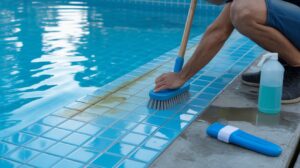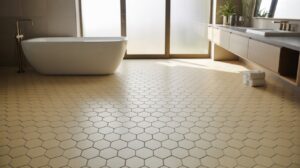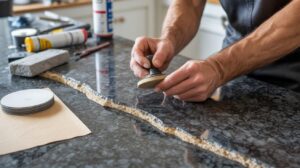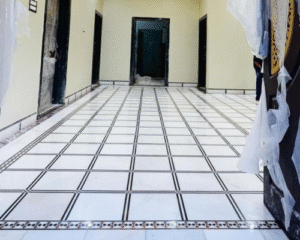Sealing marble floors means applying a special protective layer to your marble tiles, helping them stay beautiful and last longer. Because marble is a natural stone that can easily soak up liquids, sealing is one of the most important things you can do to protect your investment and keep your floors looking stunning for years to come..
Why Sealing Marble Floors Is Essential
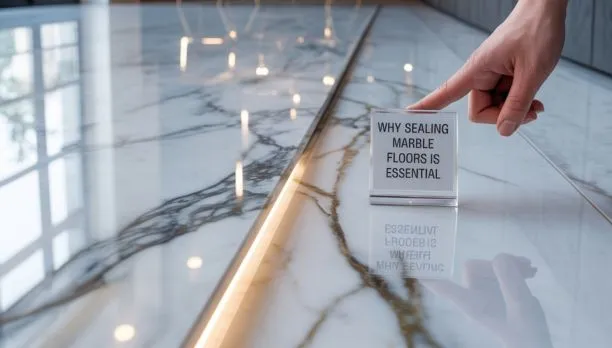
Marble floors are famous for their timeless beauty and luxurious feel, but they’re also naturally porous. This means they have tiny holes that let water, oil, and other liquids seep in, which can cause stains, dull spots, and even permanent damage if left unprotected. At SF Marble and Granite, we emphasize the importance of sealing marble floors to create a barrier that keeps out moisture and stains, making cleaning easier and helping your floors stay shiny and new.
Table of Contents
ToggleKey Benefits of Sealing Marble Floors
- Prevents stains from food, drinks, and everyday spills
- Protects against etching caused by acidic substances like juice or vinegar
- Keeps marble looking polished and beautiful for longer
- Reduces long-term maintenance costs by preventing damage
Do Marble Tiles Need Sealing?
Yes, marble tiles do need sealing. Whether your marble is on the floor, in the bathroom, or even as a kitchen backsplash, sealing is highly recommended. Without a proper seal, marble tiles can quickly lose their shine and become stained or etched by everyday use.
Can You Seal Marble?
Absolutely! Anyone can seal marble with the right tools and a little patience. Sealing is a simple process that you can do yourself at home, or you can hire a professional if you prefer. The important thing is to use a high-quality marble sealer designed for natural stone.
How to Seal Marble Floors: Step-by-Step Guide
Sealing marble floors is easier than you might think. Here’s a simple guide to help you get started:
Materials You’ll Need
- High-quality marble sealer (penetrating/impregnating type is best)
- Mild, pH-neutral detergent
- Clean, soft cloths or a foam brush
- Water and a mop or sponge
- Gloves (optional)
- Painter’s tape (optional for protecting nearby surfaces)
Step 1: Clean the Surface
Start by cleaning your marble tiles with a mild detergent and water. Use a mop or sponge to remove any dust, dirt, or sticky spots. Rinse with clean water and let the floor dry completely. This may take a few hours.
Step 2: Prepare the Area
If you want to protect walls or fixtures nearby, use painter’s tape to cover them. This keeps the sealer from getting on surfaces you don’t want to treat, especially when working with marble slabs near me, to ensure a clean and precise finish.
Step 3: Apply the Sealer
Pour a small amount of marble sealer onto a clean cloth or use a foam brush. Work in small sections, spreading the sealer evenly over the marble tiles and grout lines. Follow the instructions on your sealer for how much to use and how long to let it sit—usually about 15-20 minutes.
Step 4: Wipe Off Excess
After the recommended time, use a clean cloth to wipe away any extra sealer that hasn’t soaked in. This prevents sticky spots or streaks.
Step 5: Let It Dry and Cure
Let the sealer dry completely, usually overnight. Avoid walking on the floor or getting it wet for at least 24 hours. For the best protection, wait 2-3 days before heavy use or cleaning.
Step 6: Repeat as Needed
Most marble floors need resealing every 6-12 months, depending on how much traffic they get and where they’re located (bathrooms and kitchens may need more frequent sealing).
Marble Bathroom Floor Ideas
Marble bathroom floors are a classic choice for a reason: they look elegant, feel cool underfoot, and come in many colors and patterns. Here are some stylish ideas:
- Pale marble tiles in unique shapes (like hexagons or herringbone) add a modern twist to classic white marble.
- Basketweave mosaics bring texture and interest to your bathroom floor.
- Bold veining (like Arabesque or Marquina marble) makes a dramatic statement and adds personality to your space.
- Mix and match: Use different marble tile sizes or finishes for the floor and walls to create a custom look.
Remember, because bathrooms are high-moisture areas, sealing marble bathroom floors is especially important to prevent water stains and keep them looking great.
Transform Your Space with Professional Marble Floor Installation
Dreaming of a home that feels both timeless and luxurious? Our expert marble floor installation service brings that vision to life seamlessly and stress-free. We handle every detail, from precise measurements and surface preparation to careful tile placement and finishing touches, ensuring your marble floors are perfectly level, durable, and stunning. Whether you’re updating a bathroom, kitchen, or entryway, trust our skilled team to deliver flawless results that stand the test of time. Ready to elevate your space? Discover the difference with our marble floor installation and enjoy elegance underfoot every day.
Final Thought
Sealing marble floors is a must if you want to protect your beautiful stone from stains, moisture, and everyday wear. The process is simple, affordable, and can be done by anyone with a little care. Whether you’re installing new marble tiles or refreshing your bathroom with new marble floor ideas, sealing is the secret to keeping your investment looking its best for years to come.
FAQs
How often should I seal my marble floors?
Most experts recommend sealing marble floors every 6-12 months, but high-traffic or high-moisture areas may need sealing more often.
Can you seal marble yourself, or do you need a professional?
You can seal marble yourself by following the right steps and using a quality sealer. Professionals are a good choice for large or tricky areas.
Do marble tiles need sealing in every room?
Yes, especially in kitchens, bathrooms, and entryways where spills and moisture are common.

